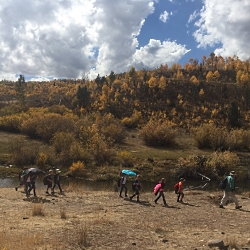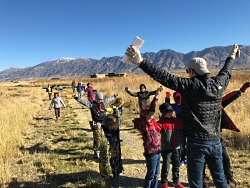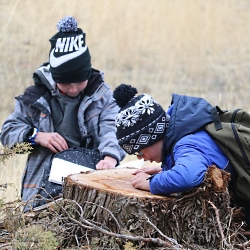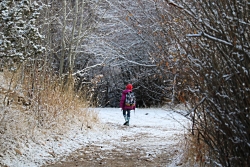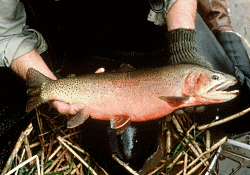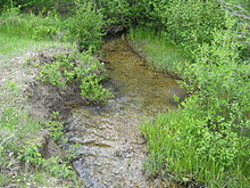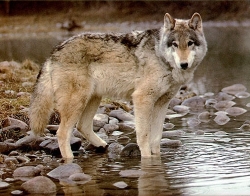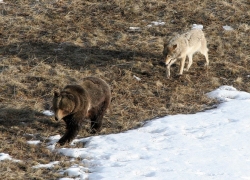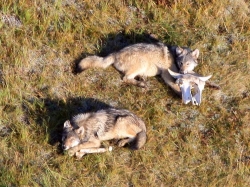- Utah is a wildly diverse place. Ecological and biological diversity are usually tied to an abundance of water; but here in Utah, despite our relative lack of the wet stuff, we boast of at least nine unique biomes spanning from the low-elevation Mojave Desert around St. George to the high Alpine Tundra of our many snowcapped mountain ranges. You can think of a biome as a large community of similar organisms and climates or a collection of similar habitats. Just recently, my third grade students wrapped up a semester-long investigation into seven of those biomes found in Utah including the high Alpine Tundra, Riparian/Montane Zone, Sagebrush Steppe, Wetlands, and the Great Basin, Colorado Plateau, and Mojave Deserts. We explored those biomes by way of researching a specific animal endemic in Utah to each of those biomes. We called our project “Habitat Heroes.” I’ll let a few of my students explain their findings.
- (Student readings)

Asher’s Gila Monster
Courtesy & Copyright EBLS
(Full Student Name Redacted) - Asher’s Gila Monster:
My name is Asher, and my animal is the Gila Monster. The Gila Monster lives in the Mojave desert biome in southwest Utah. Gila Monsters look like a lizard, just black and orange or pink and yellow with a black face and a short thick tail. Gila Monsters eat the eggs from ground birds, lizards, and snakes. Gila Monsters live in the Mojave desert in sandy areas and on rocky shelves and in burrows. - Jane’s Pygmy Rabbit:
I am Jane, and I am going to tell you about the pygmy rabbit. The pygmy rabbit lives in the sagebrush steppe biome in Utah. Did you know that a pygmy rabbit can protect itself by hiding in the sagebrush? They eat sagebrush and they drink lake water and river water. They have to chew on food to keep their teeth short. - Haven’s Red Fox:
My name is Haven, and my animal is the red fox. The red fox lives in the alpine tundra biome in Utah. Red foxes eat small mammals, berries, insects, and other food, too. They have huge ears so they can hear when other animals are coming. The red fox is a really tricky and aggressive animal because it can do a lot of really tricky and aggressive things!

Courtesy & Copyright EBLS (Full Student Name Redacted)
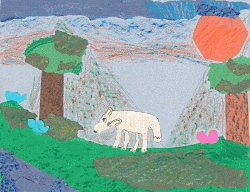
Courtesy & Copyright EBLS (Full Student Name Redacted)
In addition to researching the different biomes and learning about the adaptations animals must possess in order to survive there, these third graders have been visiting the several biomes local to Cache Valley and investigating their research animals’ habitats. These experiences have been powerful in helping students realize what it’s really like to exist in the wilds of Utah.
I’m Josh Boling, and I’m Wild About Utah!
Credits:
Images:
Artwork Courtesy & Copyright Josh Boling’s 3rd Grade students
Special thanks to Lisa Saunderson, Edith Bowen Lab School Art Teacher, for her help in instructing the students toward the creation of their artwork
Photos Courtesy & Copyright Eric Newell, Edith Bowen Laboratory School Field Experience Director
Sound:
Text: Josh Boling, 2017, Bridgerland Audubon Society
Sources & Additional Reading
Boling, Josh and students, Habitat Heroes Explore More Utah Biomes, Wild About Utah, Apr 8, 2019, https://wildaboututah.org/explore-utah-biomes/
Edith Bowen Laboratory School, https://edithbowen.usu.edu/
Biomes, Kimball’s Biology Pages, https://www.biology-pages.info/B/Biomes.html
Mission Biomes, NASA Earth Observatory, https://earthobservatory.nasa.gov/experiments/biome
The World’s Biomes, University of California Museum of Paleontology, UC Berkeley, https://ucmp.berkeley.edu/glossary/gloss5/biome/

